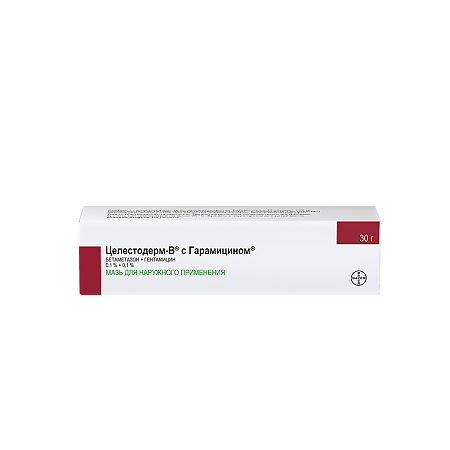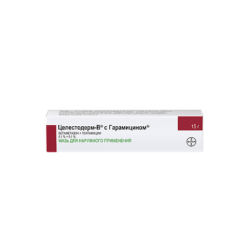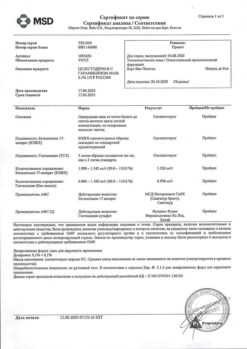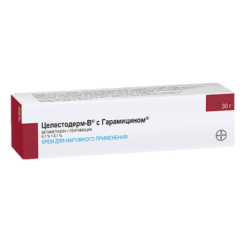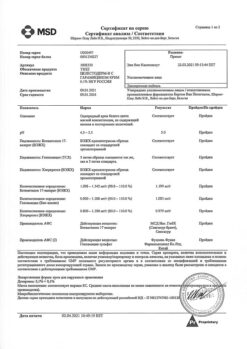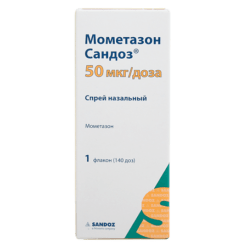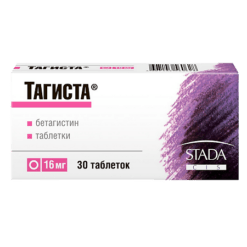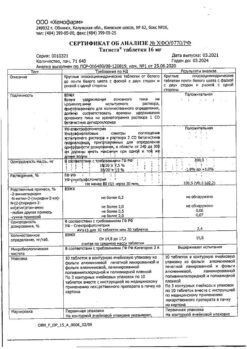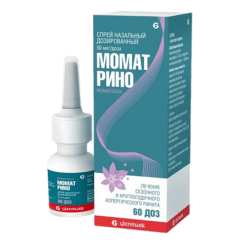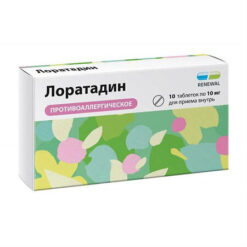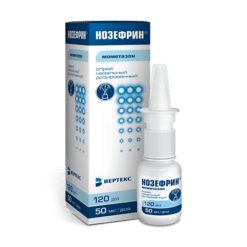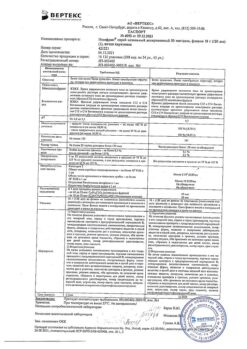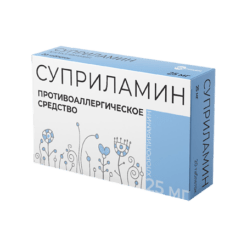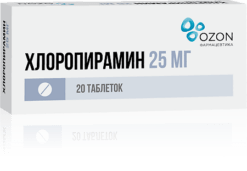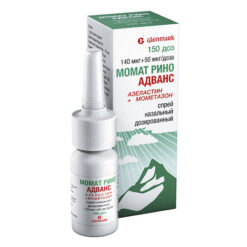No products in the cart.
Celestoderm B with Garamycin, 0.1% ointment 30 g
€21.36 €17.80
Description
Pharmgroup:
An antibiotic aminoglycoside+glucocorticosteroid.
Pharmic action:
Celestoderm-B with Garamycin is a combination drug whose action is due to the components in its composition.
Betamethasone valerate – GKS – has anti-inflammatory and anti-allergic effect, inhibits release of cytokines and inflammatory mediators, reduces metabolism of arachidonic acid, induces formation of lipocortins having anti-edema activity, reduces vascular permeability.
Gentamicin, a broad-spectrum antibiotic, is effective against most common pathogens when used topically. Bacteria susceptible to gentamicin include sensitive strains of streptococcus (beta-hemolytic, alpha-hemolytic), Staphylococcus aureus (coagulase-positive, coagulase-negative and some penicillinase-producing strains) and Gram-negative bacteria: Pseudomonas aeruginosa, Aeobacter aerogenes, Escherichia coli, Proteus vulgaris and Klebsiella pneumoniae.
Indications
Indications
Topical treatment of skin diseases amenable to GCS therapy in the presence of secondary infection caused by microorganisms susceptible to gentamicin, or with suspicion of such an infection:
– eczema (atonic, pediatric, coinous);
– contact dermatitis;
– seborrheic dermatitis;
– neurodermitis;
– sun dermatitis;
– exfoliative dermatitis;
– radiation dermatitis;
– diaper rash;
– psoriasis;
– anogenital and senile itching.
The Celestoderm-B ointment with garamycin is used for skin lesions with a background of eczema or psoriasis, and the cream is used for diseases of wet or oily skin.
Active ingredient
Active ingredient
Composition
Composition
How to take, the dosage
How to take, the dosage
Externally. Apply a thin layer on the affected areas of the skin twice a day – in the morning and in the evening.
The frequency of application, other than recommended, can be determined by a physician based on the severity of the disease.
In mild cases, once-daily dosing is usually adequate; more frequent dosing may be needed for more severe lesions.
Special Instructions
Special Instructions
Celestoderm B is not intended for use in ophthalmology.
When using the drug on large surfaces and/or with an occlusive dressing one should be aware of the possibility of systemic action of betamethasone as well as the following side effects: maceration of the skin, accession of secondary infection, skin atrophy, stretch marks, sweating.
If bacterial and fungal microflora resistant to the drug appear the drug should be discontinued and the appropriate therapy should be prescribed.
Pediatric use
The drug is indicated for children only with strict indications and under medical supervision because of possible systemic side effects associated with betamethasone: suppression of hypothalamic-pituitary-adrenal system function and development of hypercorticism symptoms. In addition, there may be a decrease in growth hormone excretion as well as an increase in intracranial pressure.
Contraindications
Contraindications
– Hypersensitivity to any of the ingredients of the drug.
– Tuberculosis of the skin.
– Skin manifestations of syphilis.
– Chicken pox.
– Herpes simplex.
– Fungal skin diseases.
– Vaccination period and skin postvaccination reactions.
– The period of lactation.
– Pregnancy (long-term treatment of large skin areas).
– Childhood age up to 6 months.
With caution:
– Pregnancy (in the absence of contraindication criteria), especially in the 1st trimester.
– Prolonged treatment of large areas of skin, especially in children.
– In the presence of skin fissures or the use of occlusive dressings.
Overdose
Overdose
Symptoms: Excessive or prolonged use of topical GCS may cause suppression of pituitary-adrenal function, which may result in secondary adrenal insufficiency and symptoms of hypercorticism, including Cushing’s syndrome. A single overdose of gentamicin is not accompanied by the appearance of any symptoms. Prolonged use in doses greater than recommended may result in a significant growth of insensitive flora, including fungal flora, in the lesion.
Treatment: appropriate symptomatic treatment is indicated. Acute symptoms of hypercorticism are usually reversible. Correction of electrolyte imbalance is indicated if necessary. In case of chronic toxicity, gradual withdrawal of GCS is recommended. In case of uncontrolled microbial growth, appropriate antibacterial or antifungal treatment should be selected.
Pregnancy use
Pregnancy use
Because the safety of topical GCS in pregnant women has not been established, the use of this class of drugs during pregnancy is justified only if the benefits to the mother clearly outweigh the possible harm to the fetus.
The GCSs should not be used for long periods or in high doses during pregnancy.
As it has not yet been determined whether GKS can penetrate into breast milk with topical use and systemic absorption, a decision should be made to discontinue breastfeeding or to discontinue the drug, given the need for the mother.
Similarities
Similarities
Additional information
| Conditions of storage | Store at a temperature not exceeding 25 ° C. |
|---|---|
| Manufacturer | Schering-Plough Labo N.V., Belgium |
| Medication form | topical ointment |
| Brand | Schering-Plough Labo N.V. |
Other forms…
Related products
Buy Celestoderm B with Garamycin, 0.1% ointment 30 g with delivery to USA, UK, Europe and over 120 other countries.

